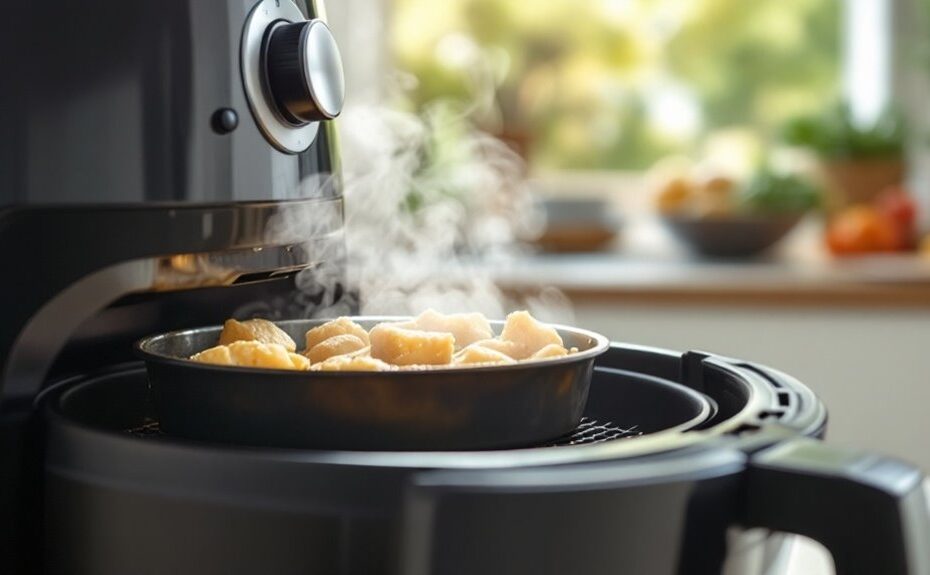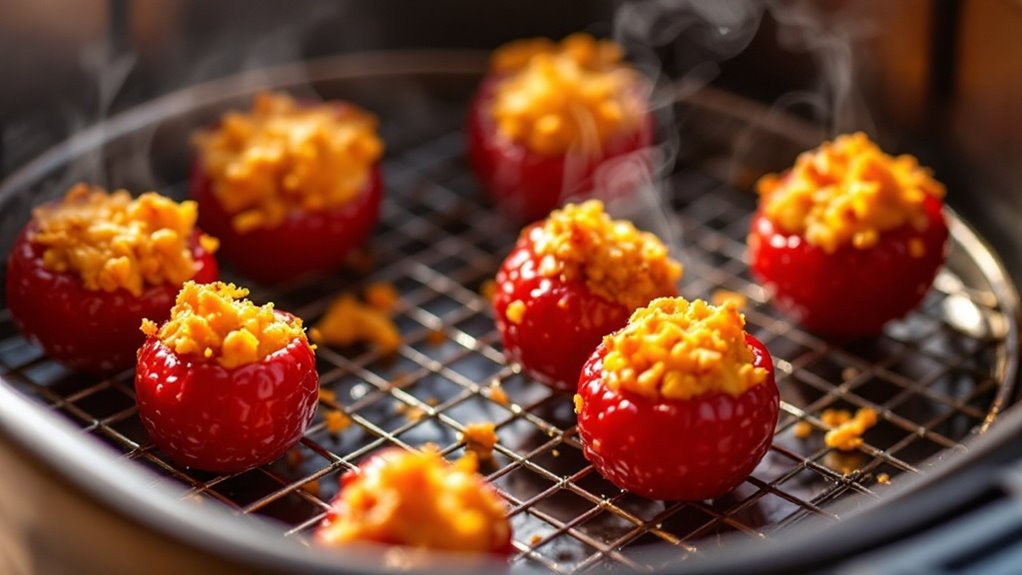If your air fryer starts smoking, it's often due to grease buildup, improper oil use, or overcrowding. You can avoid this by cleaning the basket and tray regularly, ensuring no residue lingers. Preheating the appliance and using oils with high smoke points sparingly also helps. But what if smoke still appears mid-cook? The solution might surprise you, and it's simpler than you think. Understanding how to balance airflow, temperature, and food placement could make all the difference. Ready to uncover the key steps to keep your air fryer smoke-free and running smoothly? Let's explore further.
Key Takeaways
- Clean the air fryer basket, tray, and heating element regularly to remove grease and residue that can cause smoking.
- Use oils with high smoke points, like avocado or canola, and apply them sparingly to avoid excess oil buildup.
- Avoid overfilling the basket to ensure proper airflow and prevent uneven cooking or smoking.
- Preheat the air fryer and cook at lower temperatures for fatty foods to minimize oil splatter and overheating.
- Pat down high-fat foods with a paper towel before cooking to reduce excess oil and smoking risks.
Clean the Air Fryer Regularly
To prevent your air fryer from smoking, you should clean it regularly, as leftover food particles and grease can burn during use. Start by unplugging the appliance and letting it cool completely. Remove the basket and tray, then wash them with warm, soapy water to eliminate any residue. Use a non-abrasive sponge to avoid scratching surfaces. Next, inspect and clean the heating element by gently wiping it with a damp cloth to remove any buildup. Check for residue in hard-to-reach areas, such as around the fan or vents, using a soft brush or cotton swab. Avoid submerging the main unit in water. Regular cleaning guarantees efficient airflow and prevents smoke caused by burnt debris. Always dry all parts thoroughly before reassembling.
Avoid Overfilling the Basket
Overfilling the air fryer basket can lead to uneven cooking and excessive smoke, as overcrowding restricts proper airflow. Always adhere to the basket capacity guidelines provided in your air fryer's manual. Arrange food in a single layer, leaving space between items to guarantee hot air circulates evenly. Stacking or piling food blocks airflow, causing some areas to cook faster while others remain undercooked, which can also trigger smoking. For larger batches, cook in multiple rounds instead of exceeding the basket capacity. Proper food arrangement not only prevents smoke but also secures consistent results. Avoid filling the basket more than halfway for most foods, especially those that expand during cooking, like fries or battered items. Following these steps maximizes efficiency and minimizes smoke.
Use the Right Amount of Oil
Measure oil accurately to prevent excess oil from dripping and causing smoke. Avoid over-oiling food by lightly coating it with a brush or tossing it in a small amount of oil. Use an oil spray sparingly, holding it 6-8 inches away to guarantee even, light coverage without pooling.
Measure Oil Accurately
When using an air fryer, adding too much oil can lead to smoking and uneven cooking, so it's essential to measure it accurately. Follow oil measurement tips to guarantee precise oil usage. Use a kitchen scale or measuring spoons to portion oil instead of eyeballing it. For most foods, 1-2 teaspoons of oil per serving is sufficient. Lightly coat ingredients with a spray bottle or brush to distribute oil evenly without excess. Avoid pouring oil directly into the air fryer basket, as it can pool and cause smoke. Stick to oils with high smoke points, like avocado or canola, and measure them carefully. Precise oil usage not only prevents smoking but also enhances crispiness and flavor without overwhelming your dish.
Avoid Over-Oiling Food
To prevent your air fryer from smoking, it's crucial to use just enough oil to coat your food without overdoing it. Over-oiling can lead to excess oil dripping into the heating element, causing smoke. Choose the right oil type selection, such as oils with high smoke points like avocado or refined coconut oil, to minimize smoking. Lightly brush or toss your food with oil, ensuring even coverage without pooling. Food moisture control is also critical—pat dry ingredients like vegetables or proteins before adding oil to avoid excess steam, which can mix with oil and create smoke. By balancing oil application and moisture, you'll achieve crisp, smoke-free results while maintaining your air fryer's performance and longevity.
Use Oil Spray Lightly
While using an oil spray can help evenly distribute oil, it's easy to overdo it and create excess that drips into the heating element, leading to smoke. Choose high-smoke-point oil types like avocado or refined coconut oil to minimize smoking. When applying, hold the spray bottle 6-8 inches away from the food and use short, controlled bursts. Avoid spraying directly into the air fryer basket; instead, lightly coat the food itself. If you're using a manual pump sprayer, make sure it's clean and free of residue to prevent uneven application. For better spray techniques, consider using a refillable oil mister to control the amount more precisely. Remember, a light coating is all you need—excess oil not only causes smoke but can also make food greasy.
Preheat the Air Fryer Properly
Always preheat your air fryer to the correct temperature setting before adding food to prevent uneven cooking and smoking. Clean the basket and interior thoroughly to remove any leftover residue, as debris can burn and produce smoke during preheating. Proper preheating guarantees consistent heat distribution and reduces the risk of smoking during cooking.
Ensure Correct Temperature Setting
Setting the correct temperature and preheating your air fryer properly can prevent smoking and guarantee even cooking. Start by verifying your air fryer's temperature calibration to confirm it matches the settings you select. Overheating due to inaccurate calibration can cause oil or food particles to burn, leading to smoke. Always preheat the air fryer for 2-3 minutes at the recommended temperature for your recipe. This step secures consistent heat distribution, reducing the risk of hot spots that can scorch food. Avoid exceeding the maximum temperature for delicate foods, as high heat can cause oils to smoke. Use a kitchen thermometer to double-check internal temperatures if needed. Proper temperature management not only prevents smoking but also enhances cooking efficiency and food quality.
Clean Before Preheating
Properly preheating your air fryer starts with guaranteeing it's clean before use. Food residue or grease left on the clean heating element or interior surfaces can burn during preheating, causing smoke. Before turning it on, inspect interior surfaces for any leftover debris or oil buildup. Wipe down the basket, tray, and heating element with a damp cloth or sponge, using mild soap if necessary. Avoid harsh cleaners that could damage components. For stubborn grease, soak removable parts in warm, soapy water, then scrub gently. Dry all parts thoroughly to prevent moisture from interfering with heating. A clean air fryer guarantees efficient airflow and prevents smoke caused by burning residue. Always perform this step before preheating to maintain peak performance and avoid unnecessary smoke.
Remove Excess Food Debris Before Cooking
Before you start cooking, it's essential to check for and remove any leftover food debris from the air fryer basket or tray. Proper food preparation includes inspecting the basket for crumbs, grease, or residue from previous meals. Use a soft brush or damp cloth for debris removal, ensuring no particles remain that could burn and cause smoke during cooking. Pay attention to hard-to-reach areas, such as corners or mesh surfaces, where debris often accumulates. If you notice stubborn residue, soak the basket in warm, soapy water before scrubbing gently. Always dry the basket thoroughly to prevent moisture-related smoking. Regular debris removal not only prevents smoke but also maintains your air fryer's performance and extends its lifespan. Make this step a habit before every use.
Choose the Correct Cooking Temperature
After confirming your air fryer is free of debris, the next step is selecting the right cooking temperature. Proper temperature control tips are essential to prevent smoking. Overheating can cause food particles or oil to burn, leading to smoke. Always follow the recommended temperature settings for your specific food. If you're unsure, start at a lower temperature and increase gradually. Cooking time adjustments may be necessary when lowering the heat—extend the time slightly to guarantee thorough cooking. Avoid exceeding the smoke point of oils, typically around 375°F to 450°F, depending on the type. Use a food thermometer to check internal temperatures for accuracy. By maintaining precise temperature control and adjusting cooking times accordingly, you'll minimize the risk of smoke and achieve better results.
Avoid Cooking High-Fat Foods Excessively
While high-fat foods can be delicious, cooking them excessively in an air fryer can lead to smoking issues. Fatty foods release oils during cooking, which can accumulate and overheat, causing smoke. To prevent this, practice oil control by patting down greasy items like bacon or chicken wings with a paper towel before cooking. Avoid adding extra oil unless necessary, as most fatty foods already contain enough natural fats. Use a lower temperature and shorter cooking time to minimize oil splatter and overheating. If you notice smoke, pause cooking, let the air fryer cool, and wipe away excess oil from the basket and tray. Regularly clean your air fryer to remove built-up grease, ensuring it operates efficiently and reduces smoking risks.
Disclosure: As an Amazon Associate, I earn from qualifying purchases.



